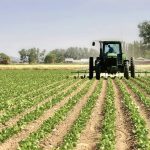
Preparing for African swine fever
Canada is developing a plan and producers urged to tighten biosecurity

Powerful sensors on planes can detect crop nitrogen
Hyperspectral imagery offers cost-effective, quick assessment

Managing herbicide-resistant weeds in corn
Planning and variety in rotations is a large factor, but cover crops and herbicide programs help too

‘Stacking’ of row-crop tillage shows promise
Three modes of action monitored in organic crop study

Many factors involved in mastering precision wheat
Planting, application and equipment considerations affect process

Producers drive land value market, realtors say
Non-farm investors tend to purchase farm land when crop margins are thin and farmers can’t pay a premium
Bayer launches herbicide with two modes of action

Wool advocates hope to boost domestic sales
Industry says synthetic materials pushed wool out of fibre markets, but consumer demand for sustainability is growing

Comment: Multiple factors at play for fertilizer price increase
High prices in Canada are in line with prices globally

Investigation underway into non-louse-related itching in cattle
Lousy reports leave veterinary researchers itching to dig deeper


